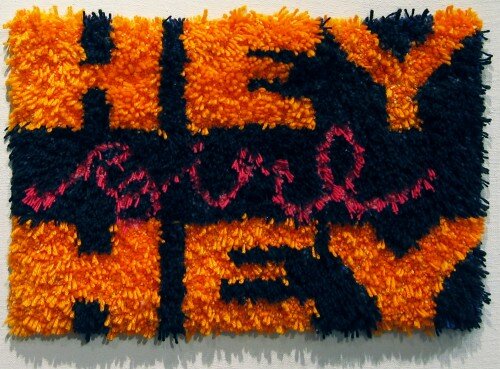“WELCOME” MATS
1997-2007
“Welcome”
This ongoing project consists of welcome mats for the not necessarily welcome. Just as actual welcome mats cannot be taken to mean that anyone standing upon the doorstep is welcome within, my welcome mats should not be taken to mean literally what they say. They may accuse the potential guest of nefarious acts, or suggest a possible course of action, but as much as they might mean what they say, they more likely hope merely to attract attention to themselves and ask the viewer to consider what they mean.
MAKEUP! is an imperative screamed by a producer imploring her makeup crew to come and attend to someone not yet suitable for broadcast, as witnessed by me while waiting for my valuation on Antiques Roadshow, Saskatoon.
"You’re only here for TV reasons" is an accusation from one contestant to another, in one of the more trashy reality series.
"Whatever BITCH whatever" is a common epithet hurled back and forth on sleazy talk shows; this phrase was made popular on Jerry Springer.
"HEY girl HEY" and "whatever BITCH whatever" are phrases spawned by reality TV that have become so ubiquitous as to practically transcend literal meaning.
"I TIVO everything" is an overheard claim made off-camera by one TV personality to another.
The Welcome to Reality series of 5 rugs in this exhibition were taken directly from, or inspired by, reality television. You’re only here for TV reasons is an accusation from one contestant to another, in one of the more trashy reality series, MAKEUP! is an imperative screamed by a producer imploring her makeup crew to come and attend to someone not yet suitable for broadcast, I TIVO everything is an overheard claim made off-camera by one TV personality to another, and HEY girl HEY and whatever BITCH whatever are phrases spawned by reality TV that have become so ubiquitous as to practically transcend literal meaning.
As the lowest common denominator of contemporary entertainment, reality television is not only the cheapest form of television to produce, but it’s become in fact a massive cultural phenomenon that has made an indelible impact on our language, arts, philosophies and intellectual pursuits as well as everyday life. I believe that the camera has created a liminal space between reality and artificialdom, or obscurity and celebrity, or privacy and total surveillance -a space that we might call “reality.” The camera has been situated so as to act as a filter of everything we do – through surveillance, filming our lived ‘reality’ for television or webcam sites, or providing the opportunity to compare our own realities to countless others via watching TV and the internet. I want to create tiny opportunities to experience and reflect upon that space created when we exist simultaneously both in real life and within the potentially monitored “reality”. In this work, as the creator of the messages, I am the imagined surveillor and as such I hope to experience what it is like to be on the outside of that liminality as it is experienced, looking in.
From the ongoing "Welcome" Mat series. In the collection of the Saskatchewan Arts Board.
While traditional rug hooking enjoys a position of honour among traditional craft forms, Latch hooking as an activity, (as well as the finished product) for the most part, is seen by the craft and mainstream communities as an amateur form evocative of a 1970′s aesthetic. It is actually for these reasons that I am attracted to latch hook; the potential for emotional and aesthetic baggage carried by the medium itself is the perfect platform for my work. It is a craft form within the field described by artist and cultural theorist Allyson Mitchell as “abandoned craft,” and as such, most of the materials for these works have been found in second hand shops and at garage sales. Where traditional rug hooking is more suited to an organic process, latch hook is more suited to pattern-based craft, which is likely why it enjoyed such popularity in its time; detailed images are easily patterned and replicated by amateur enthusiasts (and its’ seriously labour-intensive nature is certainly what led to its decline in relative short order). In my own latch hook works, I enjoy the tension between pattern and freehand, grid and scrawl. In the same way that I am interested in creating a tension between the message and how it is conveyed, it’s important to me to create a sense that the works were quickly smeared across the canvas, though it’s obvious that it took many hours to create, and that it would in fact be easier to make square words following the grid than it is to replicate a lazy tilt in the text or uncomfortable smooshing up of letters towards the end of a crowded line of words as the text is rendered in these rugs. This has evolved from an ongoing interest in the language of handwritten signs and a practice that has for a long time focused on found text and casual language translated into the written word.
In the collection of the Alberta Foundation of the Arts
Handwritten text is especially interesting to me; the “body language” of written communication, just as in person-to-person communication, often says as much or more about the message and the writer than the words themselves. (Imagine a hastily scrawled warning sign, a love letter riddled with errors in spelling and grammar, a fancily engraved “out of order” plaque for a bathroom stall.) I am interested in semiotics and the peculiarity that how we present messages often affects more of a response than the words themselves. In my work I often translate casual conversation into written word, as I feel we don’t have the opportunity to examine spoken word as often as we should, because of its fleeting nature. Its very translation into the written word often points out its’ uniqueness from written language.






